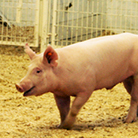Enzymes and their Application in Swine Diets
Posted: March 30, 2016 | Written By: Simon Kern, M.S.

The genetic and management advancements in swine production over the past few decades have created a pig which is extremely efficient at converting grains to protein rich pork. Despite these advances, there is still a large portion of the nutrients fed to pigs which go undigested. These undigested nutrients not only represent a lost opportunity cost in the form of feed, but they also add to the waste nutrient load produced by a pig. While these waste nutrients (nitrogen, phosphorus, and potassium) are reincorporated into most production systems as crop fertilizer, they are not looked upon favorably by environmental regulators. Moreover, crop production forms of NPK are more cost effective to apply directly to cropland than intentionally over supplementing feed forms of NPK to pigs and applying the undigested portions.
Feed enzymes are a tool swine producers can utilize to not only improve their pigs’ feed efficiency and subsequently reduce their cost of gain, but also reduce their waste nutrient outflow. The dictionary definition of an enzyme is a substance produced by a living organism that acts as a catalyst to bring about a specific biochemical reaction. In other words, enzymes either initiate or speed up chemical reactions. Feed enzymes are commercially produced by the fermentation of selected microorganisms which produce a desired enzyme. Determining what feed ingredients or compounds are poorly digested by the pig is the initial step in selecting which enzymes may be helpful in improving efficiency. Then these poorly digested compounds need to be matched to the enzyme which will break them down to a simpler, more usable form. For example, the enzyme amylase can be fed to accelerate the breakdown of starch to simple sugars.
Most of the feed ingredients traditionally used in hog production have at least one naturally occurring component which cannot be fully digested and reduces feed efficiency. This includes the protein-starch matrix in corn, beta glucans in soybean meal, xylans in distiller’s grains, and phytate in all plant-based ingredients. While these compounds represent a lost opportunity cost in the form of feed efficiency and nutrient overfeeding, many of them also illicit an immune response in the gut as the pig’s immune system identifies them as foreign. This is intensified in young pigs as their naïve immune system has never been exposed to these compounds. An immune response draws resources away from pathogens and other legitimate foreign invaders. Additionally, mounting an immune response is a very energy expensive process and redirects energy which would otherwise be used for growth.
Adding specific enzymes to feed which match the profile of the poorly digested compounds is an excellent strategy to reduce the impact of these negative effects. For example, adding a combination of enzymes which aid in the digestion of protein (protease), starch (amylase), beta glucans (beta glucanase), xylans (xylanase), and phytate (phytase) would unlock a greater proportion of the nutrients from a diet containing predominately corn, soybean meal, and distiller’s grains. This in turn improves feed efficiency and reduces cost of gain. Nutritionists take the effects of these enzymes into account when formulating rations by reducing the amount of added nutrients and reducing diet cost. For example, adding phytase to a diet will reduce the required amount of added phosphorus in the diet. Feeding enzymes which improve the digestibility of nutrients which provide energy (amylase, xylanase, etc.) will allow for either a reduction in added dietary fat with no reduction in performance or improved performance with the same level of dietary fat.
While some enzymes such as phytase have been used for decades in the swine industry, the advances and further application of additional enzyme technologies has grown tremendously over the past few years. From the introduction of enzymes to swine nutrition until the present, Form-A-Feed has and remains at the cutting edge of these technologies in order to better serve our customers. Contact your Form-A-Feed representative for more information regarding enzyme feeding and how to best apply these products to your unique production system.